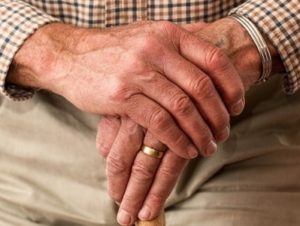Rheumatoid and Osteoarthritic Conditions of the Hand and Wrist
The smaller structures of the hand and wrist make them susceptible to the development of rheumatoid and osteoarthritic conditions. When arthritis manifests in the hands, it can hinder our ability to perform daily routine activities, limit our range of motion, and seriously impact our independence and quality of life.
What is Arthritis?
 Arthritis is defined as painful inflammation and stiffness in the joints of the body. More than one classifications of arthritis exist, with osteoarthritis and rheumatoid arthritis representing the most widespread conditions. Arthritis is a disease that affects people of all ages and is the leading cause of disability in America.
Arthritis is defined as painful inflammation and stiffness in the joints of the body. More than one classifications of arthritis exist, with osteoarthritis and rheumatoid arthritis representing the most widespread conditions. Arthritis is a disease that affects people of all ages and is the leading cause of disability in America.
Osteoarthritis (OA), also called degenerative joint disease, is the most prevalent form of arthritis affecting more than 30 million Americans adults. OA manifests most often in the hands, hips, and knees, and is most commonly seen in people aged 65 and over.
Rheumatoid arthritis (RA) is a chronic autoimmune disease in which inflammation materializes in the lining of the joints, resulting in pain, swelling, and joint deformities, and typically impacts the same joint symmetrically on both sides of the body.
RA normally occurs in patients between 30 to 60 years old and typically begins to manifest in the smaller joints of the hand. The disorder impacts roughly 1.5 million adults in the U.S. and affects almost three times more women than men.
Causes and Risk Factors for Arthritis
Factors that contribute to OA include:
- Genetic predisposition – some genetic defects can increase the likelihood of developing OA such as the body’s inability to produce enough collagen, the protein that nourishes cartilage.
- Obesity – being overweight places undue stress on the body’s structures and is linked to OA in the hands. Medical studies have demonstrated that excess fatty tissue generates inflammatory chemicals that can damage the joints.
- Injury and overuse – Repetitive motions at work or with athletes in sport can accelerate the deterioration of cartilage and lead to osteoarthritis. Joint injury (fractures or ligament tears) or repeated damage can also cause cartilage to wear down, opening the door to OA.
The causes of RA are not yet fully understood, however, many doctors link RA to genetic factors that may make patients more vulnerable to certain bacteria that may trigger the disease.
What is known is that RA comes about when the body’s immune system goes haywire and attacks the synovium – the lining of the membranes that surrounds the joints. The result is deterioration of the cartilage and bone within the joint.
Symptoms of Arthritis in the Hands
 OA symptoms can fluctuate, depending on the location and the severity of the condition. Pain and stiffness, especially upon waking or after resting are the most prevalent symptoms. Symptoms tend to get worse over time rather than showing up suddenly.
OA symptoms can fluctuate, depending on the location and the severity of the condition. Pain and stiffness, especially upon waking or after resting are the most prevalent symptoms. Symptoms tend to get worse over time rather than showing up suddenly.
Other symptoms of OA include:
- Pain or stiffness that worsens after exercise or stress on the joint
- Tenderness when palpating the joint
- Cracking, scraping, or grating sounds when the joint is moved
- Pain that interferes with sleep
- Bone spurs, firm bits of bone, may form around the affected joint
Patients with RA may exhibit the following symptoms:
- Stiff and swollen joints upon awakening that can last up to an hour
- Pain, swelling, or redness in the hands, wrists, or knuckles occurring symmetrically on both sides of the body; sometimes the joints will feel numb, tingly, or hot to the touch
- Fever, fatigue, weight loss or decreased appetite
- Firm bumps along the fingers or the elbow
- Nodules under the skin
- Sudden incapacity to straighten or bend a finger
- Bones in the wrist that stick out
Over time, the joints may lose their range of motion and become deformed.
Non-surgical Treatment for Arthritis
 Although there is no cure for OA, conservative treatment methods exist that aim to alleviate joint pain and restore function and mobility. Non-surgical treatments for OA have included:
Although there is no cure for OA, conservative treatment methods exist that aim to alleviate joint pain and restore function and mobility. Non-surgical treatments for OA have included:
- Rest
- Losing weight
- Regular physical activity
- Strengthening and range of motion exercises provided by a physical or occupational therapist
- Pain or anti-inflammatory medication
- Corticosteroid injections
- Assisted devices such as splints or sleeves
- Hot or cold treatments
The goal of RA treatment is to reduce inflammation and to limit the progression of the disease and prevent any structural damage. Over the counter, non-steroidal anti-inflammatory drugs are used to alleviate symptoms, while corticosteroid medication is used to slow the progression of the disease.
Surgical Treatment for Arthritis Pain
Both OA and RA patients who experience chronic, extreme pain and discomfort as well as severely limited movement may opt for surgery. Two types of surgical procedures are commonly used: joint fusion surgery and joint replacement/reconstructive surgery. Both types of surgery are generally performed by a board certified orthopaedic specialist trained in the area of the body where the joint will be replaced.
